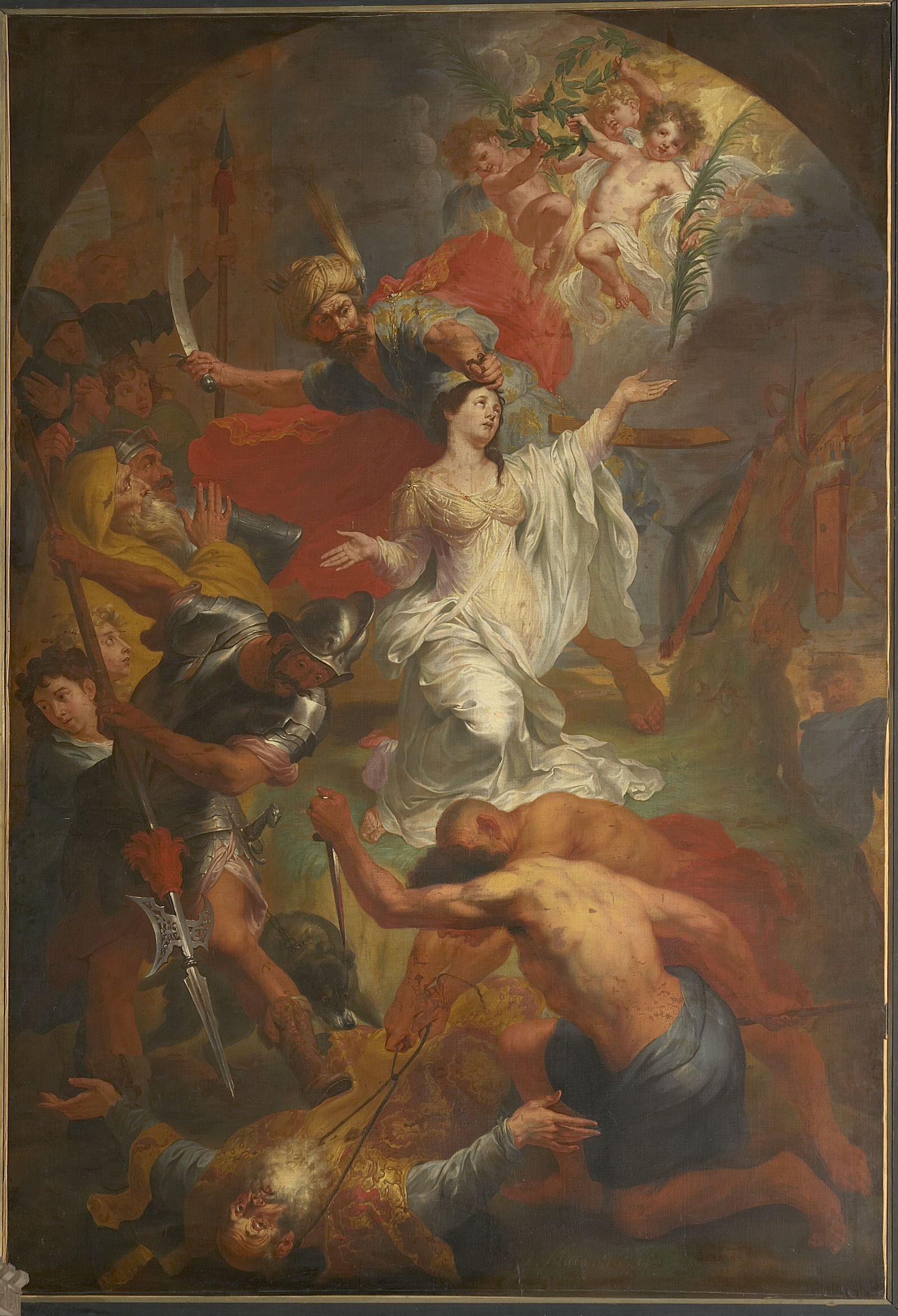Gerebernus on:
[Wikipedia]
[Google]
[Amazon]
Saint Gerebern (or Gerebernus, Genebern, Genebrard, Gereborn, Gerebran, Gerebrand, Herbern; died 7th century) was an Irish priest who baptized Saint
 Reports about miracles that happened at the grave of St. Gerebernus triggered pilgrimages there.
The pilgrimage to St. Gerebern continued in the 18th century.
The pilgrimage ended with the destruction of Sonsbeck by bombing in 1945 during
Reports about miracles that happened at the grave of St. Gerebernus triggered pilgrimages there.
The pilgrimage to St. Gerebern continued in the 18th century.
The pilgrimage ended with the destruction of Sonsbeck by bombing in 1945 during
Dymphna
Dymphna (also Dimpna, Dymfna, Dimfna, Dympna and Dympha, Irish also Damhnait or Davnet) is a Christian saint honoured in Catholic and Eastern Orthodox Church, Eastern Orthodox traditions. According to tradition, she lived in the 7th century an ...
when she was a child.
He was her companion when she fled to Belgium, where he was murdered beside her. His relics were taken to Sonsbeck
Sonsbeck is a municipality in the Wesel (district), district of Wesel, in North Rhine-Westphalia, Germany. It is situated approximately 20 km west of Wesel, and 25 km south-east of Cleves as well as 8 km from the historic city of Xa ...
in Germany, where they were an object of pilgrimage until they were destroyed during World War II
World War II or the Second World War (1 September 1939 – 2 September 1945) was a World war, global conflict between two coalitions: the Allies of World War II, Allies and the Axis powers. World War II by country, Nearly all of the wo ...
.
His feast day is 15 May.
Life
According to the biography ''Vitae Dymphnae et S. Gereberni presbiteri'' (English: Life Dymphna and St. Gerebern priest), which Peter of Cambrai, a canon of the Abbey of St-Géry-et-Aubert in Cambrai, recorded in the 13th century, Gerebernus was an Irish priest who lived in the 6th or 7th centuries. He was the tutor of Dymphna, the daughter of an Irish tribal king. After her mother's death, the king wanted Dymphna to marry. She then fled with Gerebern toGeel
Geel () is a municipality and city located in the Belgian province of Antwerp, which acquired city status in the 1980s. It comprises Central-Geel which is constituted of 4 old parishes a/o towns: Sint-Amand, Sint-Dimpna, Holven and Elsum. Furthe ...
in what is now Belgium, where they were discovered and beheaded by the king.
According to legend, both Dymphnas and Gerebernus' bones were stolen from Geel in their coffins by "robbers from Xanten".
According to popular belief, the stealing of the bones of saints was not considered theft, as they could only be stolen if the saint agreed.
However, Dymphna's bones could no longer be moved on the way to Xanten, and some citizens of Geel are said to have pursued the "robbers", so that they took some of Gerebernus' bones from the coffin and fled.
Only a few kilometers before Xanten, in the area of today's Sonsbeck, Gerebernus' bones could no longer be moved, so they were buried there and a chapel was built for him.
Legacy
 Reports about miracles that happened at the grave of St. Gerebernus triggered pilgrimages there.
The pilgrimage to St. Gerebern continued in the 18th century.
The pilgrimage ended with the destruction of Sonsbeck by bombing in 1945 during
Reports about miracles that happened at the grave of St. Gerebernus triggered pilgrimages there.
The pilgrimage to St. Gerebern continued in the 18th century.
The pilgrimage ended with the destruction of Sonsbeck by bombing in 1945 during World War II
World War II or the Second World War (1 September 1939 – 2 September 1945) was a World war, global conflict between two coalitions: the Allies of World War II, Allies and the Axis powers. World War II by country, Nearly all of the wo ...
.
Gerebernus is usually depicted as a bearded priest.
His iconographic saints' attributes are palm and lance.
St. Gerebernus is considered the patron saint against chiragra (gout-related pain in the wrist), paralysis and epilepsy.
His Catholic feast day is May 15.
Sometimes July 13 is also mentioned as a day of remembrance.
Monks of Ramsgate account
TheMonks of Ramsgate
St Augustine's Abbey or Ramsgate Abbey is a former Benedictine abbey in Ramsgate. It was built in 1860 by Augustus Pugin and is a Grade II listed building. It was the first Benedictine monastery to be built in England since the Reformation. In ...
wrote in their ''Book of Saints
St Augustine's Abbey or Ramsgate Abbey is a former Benedictine abbey in Ramsgate. It was built in 1860 by Augustus Pugin and is a Grade II listed building. It was the first Benedictine monastery to be built in England since the Reformation. In ...
'' (1921),
Butler's account
The hagiographerAlban Butler
Alban Butler (13 October 171015 May 1773) was an English Roman Catholic priest and hagiography, hagiographer. Born in Northamptonshire, he studied at the English College, in Douai, Douay, France where he later taught philosophy and theology. He s ...
(1710–1773) wrote in his ''Lives of the Fathers, Martyrs, and Other Principal Saints'' under May 15,
Baring-Gould's account
Sabine Baring-Gould
Sabine Baring-Gould (; 28 January 1834 – 2 January 1924) of Lew Trenchard in Devon, England, was an Anglican priest, hagiographer, antiquarian, novelist, folk song collector and eclectic scholar. His bibliography consists of more than 1,240 pu ...
(1834–1924) in his ''Lives Of The Saints'' wrote under April 11,
Baring-Gould writes under May 15 of St. Gerebern, or Genebrand, Priest, Martyr and Patron of Sonsbeck after an extensive account of Saint Dympna for the same day.
He notes that most of the information is given in sources that described Dympna. He goes on,
Notes
Sources
* * * * * * * * * * * {{DEFAULTSORT:Gerebern Medieval Irish saints on the Continent 7th-century deaths